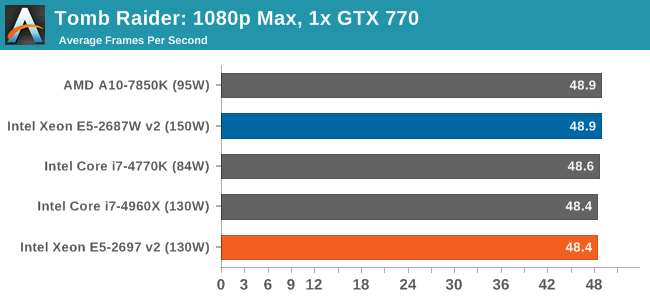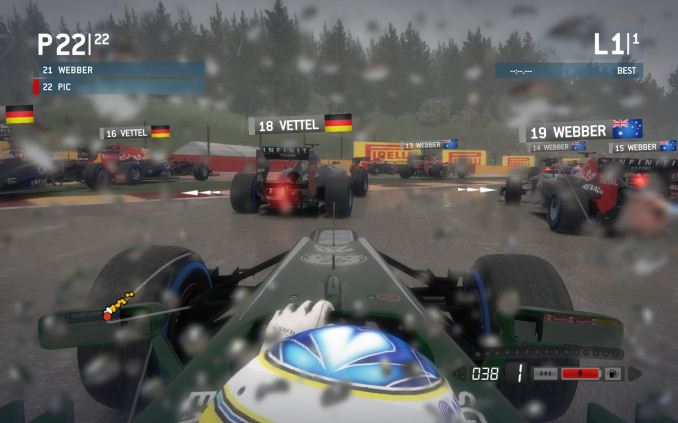Intel Xeon E5-2697 v2 and Xeon E5-2687W v2 Review: 12 and 8 Cores
by Ian Cutress on March 17, 2014 11:59 AM EST- Posted in
- CPUs
- Intel
- Xeon
- Enterprise
For our gaming benchmarks we brought in the MSI X79A-GD45 for some three-way GPU action, as the original GIGABYTE motherboard is limited beyond two GPUs. For the Xeons in our tests, the PCIe arrangement gave x16 in single GPU mode, x16/x16 in dual GPU mode and x16/x16/x8 in tri-GPU mode.
F1 2013
First up is F1 2013 by Codemasters. I am a big Formula 1 fan in my spare time, and nothing makes me happier than carving up the field in a Caterham, waving to the Red Bulls as I drive by (because I play on easy and take shortcuts). F1 2013 uses the EGO Engine, and like other Codemasters games ends up being very playable on old hardware quite easily. In order to beef up the benchmark a bit, we devised the following scenario for the benchmark mode: one lap of Spa-Francorchamps in the heavy wet, the benchmark follows Jenson Button in the McLaren who starts on the grid in 22nd place, with the field made up of 11 Williams cars, 5 Marussia and 5 Caterham in that order. This puts emphasis on the CPU to handle the AI in the wet, and allows for a good amount of overtaking during the automated benchmark. We test at 1920x1080 on Ultra graphical settings for a single GPU, as using multiple GPUs seems to have no scaling effect.

| F1 2013, 1080p Max | ||
| NVIDIA | AMD | |
| Average Frame Rates |
|
|
| Minimum Frame Rates |
|
|
While the higher frequency of the E5-2687W v2 puts it ahead of the 12-core Xeon, in each of our data points, except 3x HD7970, the Core i7-4960X gets the better frame rates.
Bioshock Infinite
Bioshock Infinite was Zero Punctuation’s Game of the Year for 2013, uses the Unreal Engine 3, and is designed to scale with both cores and graphical prowess. We test the benchmark using the Adrenaline benchmark tool and the Xtreme (1920x1080, Maximum) performance setting, noting down the average frame rates and the minimum frame rates.

| Bioshock Infinite, 1080p Max | ||
| NVIDIA | AMD | |
| Average Frame Rates |
|
|
| Minimum Frame Rates |
|
|
Again, the 8-core higher frequency Xeon is faster than the 12-core Xeon in most of our tests, however the i7-4960X beats them most of the time. For certain arrangements, such as 2x HD7970, the Xeons lose slightly to the i7-4770K, most likely due to CPU IPC. However as the difference is only a couple of frames per second out of 130, this should not make much difference.
Tomb Raider
The next benchmark in our test is Tomb Raider. Tomb Raider is an AMD optimized game, lauded for its use of TressFX creating dynamic hair to increase the immersion in game. Tomb Raider uses a modified version of the Crystal Engine, and enjoys raw horsepower. We test the benchmark using the Adrenaline benchmark tool and the Xtreme (1920x1080, Maximum) performance setting, noting down the average frame rates and the minimum frame rates.

| Tomb Raider, 1080p Max | ||
| NVIDIA | AMD | |
| Average Frame Rates |
|
|
| Minimum Frame Rates |
|
|
In all the Tomb Raider tests, all the CPUs perform similarly, making Tomb Raider a seemingly agnostic test to CPU power.













71 Comments
View All Comments
XZerg - Monday, March 17, 2014 - link
this bench also shows that the haswell had almost no CPU related performance benefits over IVB (if not slowed down performance) looking at 3770k vs 4770k and that haswell ups the gpu performance only.i really question intel's skuing of haswell...
Nintendo Maniac 64 - Monday, March 17, 2014 - link
Emulation?BMNify - Monday, March 17, 2014 - link
its a shame they didn't do a UHD x264 encode here as that would have shown a haswell AVX2 improvement (something like 90% over AVX), and why people will have to wait for the xeons to catch up to at least AVX2 if not AVX3.1psyq321 - Wednesday, March 19, 2014 - link
There is no "90% speedup over AVX" between HSW and IVB architectures.AVX (v1) is floating point only and thus was useless for x264. For floating point workloads you would be very lucky to get 10% improvement by jumping to AVX2. The only difference between AVX and AVX2 for floating point is the FMA instruction and gather, but gather is done in microcode for Haswell, so it is not actually much faster than manually gathering data.
Now, x264 AVX2 is a big improvement because it is an integer workload, and with AVX (v1) you could not do that. So x264 is jumping from SSE4.x to AVX2, which is a huge jump and it allows much more efficient processing.
For integer workloads that can be optimized so that you load and process eight 32-bit values at once, AVX2 Xeon EPs/EXs will be a big thing. Unfortunately, this is not so easy to do for a general-purpose algorithms. x264 team did the great job, but I doubt you will be using 14 core single Haswell EP (or 28 core dual CPU) for H.264 transcoding. This job can be done probably much more efficient with dedicated accelerators.
As for the scientific applications, they already benefit from AVX v1 for floating point workloads. AVX2 in Haswell is just a stop-gap as the gather is microcoded, but getting code ready for hardware gather in the future uArch is definitely a good way to go.
Finally, when Skylake arrives with AVX 3.1, this will be the next big jump after AVX (v1) for scientific / floating point use cases.
Kevin G - Monday, March 17, 2014 - link
Shouldn't both the Xeon E5-2687W v2 support 384 GB of memory? 4 channels * 3 slots per channel * 32 GB DIMM per slot? (Presumably it could be twice that using eight rank 64 GB DIMMs but I'm not sure if Intel has validated them on the 6 and 10 core dies.) Registered memory has to be used for the E6-2687w v2 to get to 256 GB, just is the chip not capable of running a third slots per channel? Seems like a weird handicap. I can only imagine this being more of a design guideline rule than anything explicit. The 150W CPU's are workstation focused which tend to only have 8 slots maximum.Also a bit weird is the inclusion of the E5-2400 series on the first page's table. While they use the same die, they use a different socket (LGA 1356) with triple memory support and only 24 PCI-e lanes. With the smaller physical area and generally lower TDP's, they're aimed squarely the blade server market. Socket LGA 2011 is far more popular in the workstation and 1U and up servers.
jchernia - Monday, March 17, 2014 - link
A 12 core chip is a server chip - the workstation/PC benchmarks are interesting, but the really interesting benchmarks would be on the server side.Ian Cutress - Monday, March 17, 2014 - link
Johan covered the server side in his article - I link to it many times in the review:http://www.anandtech.com/show/7285/intel-xeon-e5-2...
BMNify - Monday, March 17, 2014 - link
a mass of other's might argue a 12 core/24 thread chip or better is a potential "real-time" UHD x264 encoding machine , its just out of most encoders budgets, so NO SALE....Nintendo Maniac 64 - Monday, March 17, 2014 - link
Uh, where's the test set up for the 7850K?Nintendo Maniac 64 - Monday, March 17, 2014 - link
Also I believe I found a typo:"Haswell provided a significant post to emulator performance"
Shouldn't this say 'boost' rather than 'post'?